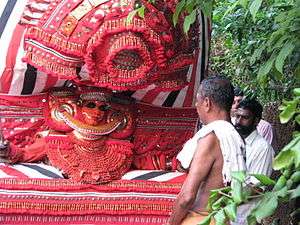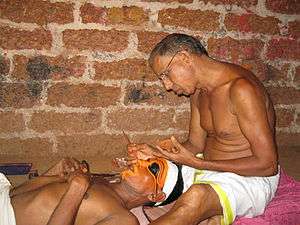Neeliyar Bhagavathi
Neeliyar Bhagavathi is a Theyyam ritual conducted in the northern part of Kerala, India. The term Neeliyar Bhagavathi refers to the goddess of the Mangattuparamba Neeliyar temple; the ritual is mainly performed in this temple. This Theyyam is usually performed in the evening, during sunset. The goddess Neeliyar Bhagavathi has temples dedicated to her in different parts of Kannur including Cherukunnu, Eranjikkal, Mathamangala, etc. This particular Theyyam is performed by the Vannan caste. A few musical instruments, like Chenda are used during the performance.

About
Theyyam rituals in northern Kerala usually begin in the month Thulam of the Malayalam calendar and end by Edavapathy month, after the Theyyam performance of Kalarivatukkal Bhagavathi at Valapattanam Kalarivathukkal temple. However, Neeliyar Bhagavathi Theyyam is conducted throughout the year. During Karkidaka month - from the 2nd day to the 16th day - this Theyyam is not performed, as it is believed that during this time the goddess is away in Kottiyoor. Families who do not have children, as well as those awaiting marriage, pray at this temple. Once their wishes are fulfilled, or in order for their wishes to be fulfilled, they conduct a Theyyam at the temple.
Legend
The legend behind Neeliyar Bhagavathi is intricate and ancient.
According to legend, in Kottiyoor, Kannur, there was once a lower-caste woman called Neeli who was extremely beautiful and intelligent. She was killed by the local ruler. Upon her death, Neeli became the Goddess Neeliyar Bhagavathi. When she was alive, Neeli lived near a sandbank. After her death, whenever travellers came near the river next to this place, Neeliyar Bhagavathi would ask them whether they needed oil and a thaali leaf (used in the place of soap in ancient time) before their bath. Whoever said yes and went near her was captured, whereupon the Goddess Neeliyar Bhagavathi would suck their blood. No one who went near the river ever returned home. Once, a personal called Kalakkad Namboothiri went there for a bath, and saw Neeliyar Bhagavathi. The Goddess asked him his name; he replied saying he was Kalakkad; and the Goddess told him that she was Kali. She then gave him oil and a thaali leaf. Kalakkad drank the oil and thaali juice saying that it was Amruthu (nectar) given to him by his mother. On seeing this, the Goddess was very happy that he called him mother, and so she spared his life, and furthermore accompanied him on his way to the west. Neeliyar Bhagavathi then revealed that she was a Goddess, and said she would like to reside in a temple where the tiger and cow live together peacefully. On their journey, Kalakkad Nambhoothiri saw a cow and tiger co-existing in Mangattuparambu, and so he put down his umbrella (made from the leaves of a palm tree) and rested there. The Goddess was accompanying him by riding atop the umbrella, and decided to stay at the place. Kalakkad Nambhoothiri subsequently set up a temple for the Goddess at the spot.[1][2]
However, M. V. Vishnu Nambuthiri, who is a scholar of Kerala folklore in general and the Theyyam ritual in particular, suggests that this story is not an official part of any of the folk songs about Neeliyar Bhagavathi herself.[3]
Costume

The Neeliyar Bhagavathi Theyyam is very similar to the Valiya Thampuratty Theyyam, a ritual form that is quite famous in other parts of Kannur. The face-painting and long crown is almost identical in both the Theyyams.
People from Vannan caste typically have the privilege of performing this Theyyam. Further, only Vannan people who have the honour of Karakkaattidam Nayanar perform this ritual. In the present time, among the main performers of this Theyyam are the Mangattuparambu Neeliyar Kaavil Daasan and Ravi.
Gallery
 The spot where Theyyam is performed
The spot where Theyyam is performed The performance
The performance Face-painting
Face-painting Face-painting
Face-painting Walking from the preparation room to the performance ground
Walking from the preparation room to the performance ground Final touches
Final touches Before the hair is worn
Before the hair is worn To the stage
To the stage On the stage
On the stage Neeliyar Bhagavathi face-painting
Neeliyar Bhagavathi face-painting Neeliyar Bhagavathi
Neeliyar Bhagavathi Neeliyar Bhagavathi
Neeliyar Bhagavathi
References
- Interview with Kalyani of Ozhakrom (2011)
- Interview with PV Knjiraman of Amsham Tthrachambaram in Thaliparambu (2011)
- Interview with Vishnu Nambuthiri (2011)